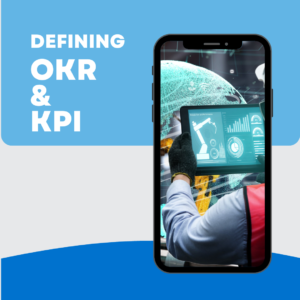Defining OKRs and KPIs
Acronyms are great, but how can you keep track of them all? Most acronyms even have more than one meaning. In this blog, we’re breaking down two acronyms that drive organizational profitability and strategy: Defining OKRs and KPIs.
So what is an OKR and KPI? OKR stands for Objective and Key Results, while KPI stands for Key Performance Indicator. Objective and Key Results is a framework, commitment and plan for organizational goal-setting. This framework outlines key objectives and targets for the business to work toward completing. But, it’s not as simple as that; top management must make a conscious effort to commit toward a central vision or mission first that aligns all of the following pieces. Notice how each objective leads to a key result and responsibility:
Think of the KPI being under the umbrella of OKR, much like a tool of the OKR. It may be the Key Result itself or supports the key result by acting on and utilizing KPIs.
A KPI is a Key Performance Indicator, this is a measurement in graphical format that allows you to perform analyses against or on different data. A KPI helps you monitor progress toward a specific objective or key result expected. Our KPI philosophy is to “Measure what you Treasure,” which means to source or connect your KPIs from overarching business goals and objectives in your OKR chart.
For example, your vision and mission could be to create the highest quality products for the most cost-effective price. This might not be quick or easy to do, but you will have core objectives and KPIs to work toward to ensure your progress. Your objectives may look like this: 1) Establish strict Quality SPC and receive real-time quality information. 2) Continually identify new ways to produce safe products. Each of these objectives can then be broken down into what key results management expects and KPIs to track and measure against departmental actions with assigned KPIs. Deriving and identifying core KPIs from your OKR chart is going to give you momentum in the continuous improvement journey. This not only helps companies improve compliance programs and process efficiency, but continually helps operations improve upon current methods.
Using OKRs & KPIs:
So then, how do effective objectives get placed and followed? The above framework shows you how to lay out your goals and objectives, but doesn’t do much to help you create them. To do that, it takes company reflection and questions that poke at what your organization exists for. Try asking yourself the following questions to use a top-down approach:
- What are impactful actions we can take now to progress toward our vision?
- What needs to change in order to improve? What needs to be eliminated?
- What does success look like?
- How can we make our employees’ lives easier?
- Where does our culture get its inspiration from?
Using these questions, you will be able to filter out what is or isn’t important and lay out an aggressive framework to build from your foundation to your vision. Each of these can be applied to various areas of operations or executive teams.
Examples of where you can use OKRs & KPIs:
- Safety (people & product/process)
- Quality
- Yield
- Productivity
- Maintenance
- Leadership/Management
- More
Take Goal-Setting to the New Level:
Goal-setting is a continuous improvement process that comes with time, experience and great tools. OKRs, KPIs and BluWave Digital Tools help you achieve your operational goals and navigate the ever-changing competitive landscape. Using a consultative, strategic approach, we identify hurdles, solutions and success metrics that sets up operations for a continuous cycle of improvement. The best part? We are there every step of the way implementing the right tools to scale your business. Every position is informed and empowered with the right goals and information at their fingertips to execute.
Keep your organization accountable and transparent with custom OKRs and KPIs that transform your operation to its next best iteration.
Digital Platform for Improving Excellence with Intelligence
Recent Blogs:
